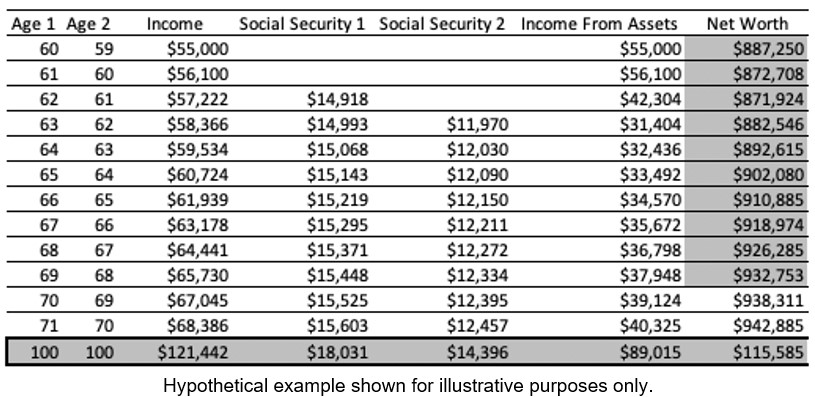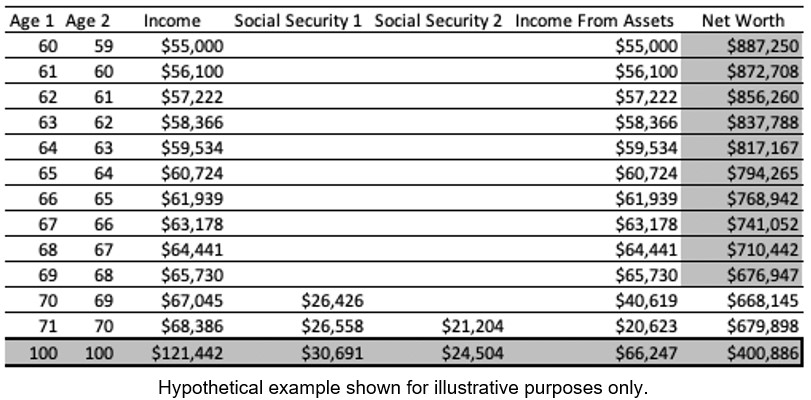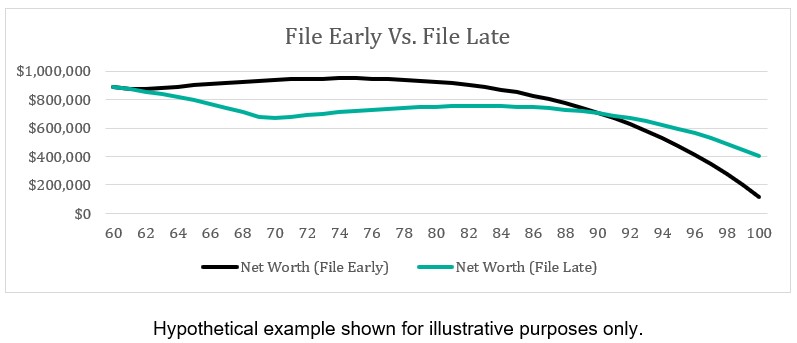Social Security Optimization If You Save More Than $250,000
When you choose to take benefits will make a difference in how your income and assets play out over many years. Let’s explore some scenarios.


If you have less than $250,000 saved for retirement, chances are your Social Security retirement benefits could be the main source of your retirement income. If this is true, then you may want to consider working as long as you can, or until age 70, and delay your retirement benefit so it can grow as much as possible. However, if you have more than $250,000 saved up for retirement, deciding when you should file for Social Security becomes a more nuanced question. Why? It’s because there can be a rippling effect throughout the rest of your retirement plan.
Assuming that your target retirement age is around 60 years old, and you expect a certain amount of income each year with a cost-of-living adjustment, your plan would need to account for the gap between when you retire and when your Social Security benefit starts.
Filing for Social Security Too Early vs. Too Late
For example, if you had a target retirement date of 60 years old and file for your Social Security benefits at 62 years and one month, you’d have a gap of about two years between when you retire and when you start receiving your benefit. That means you’d potentially have to take additional income to bridge the gap or make up the difference until your Social Security benefit started.
From just $107.88 $24.99 for Kiplinger Personal Finance
Become a smarter, better informed investor. Subscribe from just $107.88 $24.99, plus get up to 4 Special Issues

Sign up for Kiplinger’s Free Newsletters
Profit and prosper with the best of expert advice on investing, taxes, retirement, personal finance and more - straight to your e-mail.
Profit and prosper with the best of expert advice - straight to your e-mail.
If you had a target retirement date of 60 years old and intended to file for your Social Security benefits at age 70, you’d have a 10-year gap, which could have an even greater impact on your portfolio as you bridge the gap.
Admittedly, there’s no simple solution. Filing early, like around 62 or 63, has its benefits and detriments. The same goes for those who decide to file late, as in around 68 to 70. Here’s an expression I came up with some years ago to help explain how to compare the benefits and detriments potentially found when you consider your Social Security filing strategies: If you file too early, your income may be hurting. If you file too late, you could be hurting your estate.
Let’s address each option. Here is a quick breakdown of what it could look like if you were to file early.
Strategy 1: Take Social Security Early

The third column above shows the total projected retirement income for a couple with one spouse who’s younger than the other. They start receiving the older spouse’s Social Security benefit at age 62 (column four). Column five represents the younger spouse’s benefit. The projected net worth, column seven, has an assumed growth rate of 5%.
Notice how the net worth at age 71 is projected to be $942,885, and at age 100, the net worth is projected to be $115,585. During the first 10 years, because Social Security had been turned on early, the estate was better preserved. In other words, this couple did not have to take as much income from their assets to meet their retirement income goal.
Now let’s look at the other strategy and then compare.
Strategy 2: Take Social Security Late

In this strategy, notice how the net worth goes further down during the first 10 years than in the first example. This is because more income must be pulled from assets to meet the target retirement income. Essentially, the assets are bridging the gap between when this couple retires and when they file for Social Security. Once Social Security turns on at age 70, the portfolio doesn’t have to provide as much income to meet the retirement income goal.
When someone files for their Social Security benefit at 70 years old, they claim their maximum possible benefit. This helps the portfolio, growing at an assumed 5% annually, recover. This is why the portfolio has the potential to recover and is projected to be around $400,886 by age 100.
Let’s compare what the projected net worth looks like in both scenarios.

Notice how the net worth goes down when you file late. That is because the portfolio is providing all the retirement income. The green Net Worth (File Early) line illustrates how taking Social Security early, even at a discount, requires less income from the portfolio, helping the portfolio maintain a higher total balance.
It’s important to note the differences based on the years. When you compare the projected net worth at age 69, Strategy 1 projects a net worth of $932,753, while Strategy 2 projects $676,947, a $255,806 difference. That’s a lot of money potentially going to beneficiaries.
Now let’s compare the two strategies at age 100. Strategy 1 projects a net worth of $115,585, while Strategy 2 projects $400,886, a $285,301 difference. Again, that’s a lot of money to beneficiaries.
In conclusion, when you consider your Social Security strategy, it is important to review how when you file could affect your portfolio. If you are more concerned about passing as much as you can to your beneficiaries, then you may consider filing early to preserve more of your portfolio in the earlier part of your retirement. If you want to maximize your income, you may consider filing late to get the highest benefit possible.
A few other factors that may affect when you should file include how much you expect to get at full retirement age, does your spouse qualify for their own benefit, or does it make sense to consider the spousal benefits, your total retirement income and how that income is generated, and so on.
The folks who work at the Social Security Administration can help answer some questions, but they are limited in what they can and cannot do. Working with a financial adviser or using third-party software to run the numbers on your potential lifetime benefits can make a huge difference.
Social Security optimization is a nuanced process. There’s no silver bullet here. The trick is to file for your benefit based on what you value more — protecting your estate or maximizing your income.
Profit and prosper with the best of Kiplinger's advice on investing, taxes, retirement, personal finance and much more. Delivered daily. Enter your email in the box and click Sign Me Up.

Mike Decker is the author of the book How to Retire on Time, creator of the Functional Wealth Protocol, and the founder of Kedrec, a Registered Investment Advisory firm located in Kansas that specializes in comprehensive wealth planning and management at a flat fee. He specializes in creating retirement plans designed to last longer than you™, without annuitized income streams or stock/bond portfolios. In addition to helping people achieve their financial goals, Decker continues to act as a national coach to other financial advisers and frequently contributes to nationally recognized publications.
-
 I'm want to give my 3 grandkids $5K each for Christmas.
I'm want to give my 3 grandkids $5K each for Christmas.You're comfortably retired and want to give your grandkids a big Christmas check, but their parents are worried they might spend it all. We ask the pros for help.
-
 If You're Not Doing Roth Conversions, You Need to Read This
If You're Not Doing Roth Conversions, You Need to Read ThisRoth conversions and other Roth strategies can be complex, but don't dismiss these tax planning tools outright. They could really work for you and your heirs.
-
 Could Traditional Retirement Expectations Be Killing Us?
Could Traditional Retirement Expectations Be Killing Us?A retirement psychologist makes the case: A fulfilling retirement begins with a blueprint for living, rather than simply the accumulation of a large nest egg.
-
 I'm a Financial Planner: If You're Not Doing Roth Conversions, You Need to Read This
I'm a Financial Planner: If You're Not Doing Roth Conversions, You Need to Read ThisRoth conversions and other Roth strategies can be complex, but don't dismiss these tax planning tools outright. They could really work for you and your heirs.
-
 Could Traditional Retirement Expectations Be Killing Us? A Retirement Psychologist Makes the Case
Could Traditional Retirement Expectations Be Killing Us? A Retirement Psychologist Makes the CaseA retirement psychologist makes the case: A fulfilling retirement begins with a blueprint for living, rather than simply the accumulation of a large nest egg.
-
 I'm a Financial Adviser: This Is How You Can Adapt to Social Security Uncertainty
I'm a Financial Adviser: This Is How You Can Adapt to Social Security UncertaintyRather than letting the unknowns make you anxious, focus on building a flexible income strategy that can adapt to possible future Social Security changes.
-
 I'm a Financial Planner for Millionaires: Here's How to Give Your Kids Cash Gifts Without Triggering IRS Paperwork
I'm a Financial Planner for Millionaires: Here's How to Give Your Kids Cash Gifts Without Triggering IRS PaperworkMost people can gift large sums without paying tax or filing a return, especially by structuring gifts across two tax years or splitting gifts with a spouse.
-
 'Boomer Candy' Investments Might Seem Sweet, But They Can Have a Sour Aftertaste
'Boomer Candy' Investments Might Seem Sweet, But They Can Have a Sour AftertasteProducts such as index annuities, structured notes and buffered ETFs might seem appealing, but sometimes they can rob you of flexibility and trap your capital.
-
 Quick Question: Are You Planning for a 20-Year Retirement or a 30-Year Retirement?
Quick Question: Are You Planning for a 20-Year Retirement or a 30-Year Retirement?You probably should be planning for a much longer retirement than you are. To avoid running out of retirement savings, you really need to make a plan.
-
 Don't Get Caught by the Medicare Tax Torpedo: A Retirement Expert's Tips to Steer Clear
Don't Get Caught by the Medicare Tax Torpedo: A Retirement Expert's Tips to Steer ClearBetter beware, because if you go even $1 over an important income threshold, your Medicare premiums could rise exponentially due to IRMAA surcharges.
-
 I'm an Insurance Pro: Going Without Life Insurance Is Like Driving Without a Seat Belt Because You Don't Plan to Crash
I'm an Insurance Pro: Going Without Life Insurance Is Like Driving Without a Seat Belt Because You Don't Plan to CrashLife insurance is that boring-but-crucial thing you really need to get now so that your family doesn't have to launch a GoFundMe when you're gone.